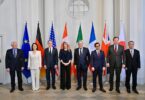F.P. Report
WASHINGTON: Based on final recommendations submitted by the DoD China Task Force, Secretary Austin issued a directive on Wednesday initiating several major Department-wide efforts to better address the security challenges posed by China as the United States’ number one pacing challenge.
These initiatives — some of which will remain classified — are designed to focus Departmental processes and procedures and better help department leaders contribute to whole-of-government efforts to address the challenge from China. They were developed in consultation and coordination with our interagency partners and will complement the multi-faceted work on China policy of departments, agencies, and the White House. Many are intended to streamline and strengthen cooperation with U.S. allies and partners, particularly in the Indo-Pacific.
“The initiatives I am putting forward today are nested inside the larger U.S. government approach to China and will help inform the development of the National Defense Strategy we are working on,” said Secretary Austin. “I am enormously proud of the work put forth by members of the China Task Force,” Austin said. “I asked a lot of them, and they delivered. Now it is time for us to move forward. The efforts I am directing today will improve the Department’s ability to revitalize our network of allies and partners, bolster deterrence, and accelerate the development of new operational concepts, emerging capabilities, future force posture, and a modernized civilian and military workforce.”
The directive also established Secretary Austin’s intent to directly oversee the Department of Defense’s China-related policies, operations, and intelligence as the Task Force’s recommendations are incorporated into ongoing reviews and Department-wide processes.
President Biden announced last February the establishment of the Task Force. It had a specific two-fold mission: to conduct a baseline assessment of China-related programs, policies, and processes at the Department of Defense; and to provide the Secretary with a set of top priorities and recommended courses of action for the Department.
Members of the Task Force were detailed from across the Department of Defense, including representatives from all the Services, several Combatant Commands, the Joint Staff, the Office of the Secretary of Defense, and the Intelligence Community.
During its tenure, the Task Force conducted hundreds of interviews and reviewed thousands of pages of policies, analysis, and intelligence.
In April, Task Force leaders delivered their initial assessment to Secretary Austin, as well as to DoD civilian and military leadership, including at the spring Senior Leaders Conference.
Having completed its work, the Task Force will now stand down. The initiatives put forth in the Secretary’s directive will be executed through — and by — normal Departmental structures and organizational elements, supplemented by new processes where necessary.
“I want to thank everyone on the Task Force for their hard work and the skill they lent to what was a sprint-like effort,” said Austin. “I especially want to note the leadership of Dr. Ely Ratner, who superbly organized and managed this body of work. Now, it is up to the Department to get to work.”






